As in many other countries animal control officers in Japan face the issue of how to deal with unwanted pets, especially dogs and cats. In the year 2008 a total of 112,690 dogs and 228,373 cats were put down by animal control authorities throughout the country.
Needless to say, though the numbers have decreased dramatically in the past 20-30 years, efforts must be made continuously to save more lives. However when considering the actual strategies that must be developed one cannot ignore the marked difference in the contents of the statistics pertaining to these animals. First of all in terms of the age of animals being abandoned, in the case of dogs, over 82 percent are adult animals whereas with cats over 71 percent are kittens. With cats, though the numbers are still high, there seems to be a decreasing trend in the percentage of kittens in inverse proportion to the percentage of cats being kept strictly indoors. Though the tradition of allowing cats to roam is slowly dying in the metropolitan areas rural cats are still being given free run of the neighborhood. It may be logical to assume that widespread spay and neuter programs would cut down on the number of kittens being brought to shelters. However this does not seem to be the case, at least in terms of statistics. According to a survey conducted by the Japan Society for the Prevention of Cruelty to Animals, in 2008
the percentage of dogs that were spayed/neutered from a subject population of about 2000, was approximately 40 percent. With cats the same percentage was 83 percent. This does not seem explain why the percentage of kittens is so high in the sbove mentioned statistics. This is one of the areas where a concentrated effort must be made to pinpoint the cause .
In the case of dogs many local animal control offices are now saying that the number of unwanted puppies is decreasing dramatically. In some areas, for example in Tokyo, there are virtually no puppies being put up for adoption by animal control, simply because there are none . However , the issue with dogs is the abandonment of adult animals. Acorrding to the JSPCA, the top reason that dogs are brought in is the death or illness of the owner. This alone accounts for one third of all dogs given up at animal control. The second reason is moving or change of abode. When the two are put together
The result is one half of all dogs being disowned by their keepers. In other words, if one were to think of an effective strategy to decrease the number of dogs being brought into shelters, one way thing that may be effective would be to create a community outreach program whereby owners would be able to receive help in caring for their dogs when they fall ill or are disabled in any way. Small scale community fostering would also help in terms of dealing with sudden or the unexpected passing of owners. Oftentimes people assume that behavioral issues lie at the heart of the surrendering of dogs. But statistics show that perhaps that is not so. Obedience classes and problem behavior hotlines may not be the best answer to deal with this problem.
In any event Japanese society as a whole must continue to look for ways in which life can be made better and safer for out four-legged friends.
This site publishes columns regarding the actual situation of animals in Japan, on a regular basis. After a period of inactivity, we re-opened the site with the intention of being of help to anyone looking for this kind of information, and furthermore, creating an opportunity for the happy and borderless co-existence of humans and animals.
- Visual concept of the AIJ icon
-
The character shown in the AIJ icon is “Akabeko”, the legendary red bull of the Aizu region in Fukushima Prefecture. It is said that Akabeko helped black cattle that were struggling to carry wood to restore a temple damaged by a big earthquake that hit the region about 400 years ago. As the Akabeko disappeared soon after its great contribution, people believed it was help sent from Buddha. People in that region have held Akabeko as a bearer of ‘Good Fortune’ ever since. The black circles on Akabeko are considered to be indications of the pox. According to another legend, the red bull was the only animal that survived smallpox infection in ancient times. People believed its red body color also had an apotropaic power and that children owning an Akabeko toy escape from misfortunes.
- Visual concept of the AIJ icon
- The character shown in the AIJ icon is “Akabeko”, the legendary red bull of the Aizu region in Fukushima Prefecture. It is said that Akabeko helped black cattle that were struggling to carry wood to restore a temple damaged by a big earthquake that hit the region about 400 years ago. As the Akabeko disappeared soon after its great contribution, people believed it was help sent from Buddha. People in that region have held Akabeko as a bearer of ‘Good Fortune’ ever since. The black circles on Akabeko are considered to be indications of the pox. According to another legend, the red bull was the only animal that survived smallpox infection in ancient times. People believed its red body color also had an apotropaic power and that children owning an Akabeko toy escape from misfortunes.
Feb.
2011
Unwanted Pets

Prepared for Zenoaq by Animal Literacy Research Institute
Jan.
2011
The Year of the Rabbit
According to the oriental zodiac, 2011 is the year of the rabbit. The rabbit has become an increasingly popular pet in Japan in recent years. A pet insurance company has recently conducted a survey on pet rabbits and has come up with some interesting facts about rabbits in this country. First of all, this particular insurance company, Anicom, a leading company in the field of pet insurance in Japan currently has 2318 rabbits insured by its
policies. Of these rabbits the most popular name is Momo. The second most popular name is Hanna. The third place goes to Choco, the fourth to Marron, and the fifth placer goes to the name Mimi. It was very interesting to note that in a similar survey of pet names done by the company on pet dogs the first through the fourth place for rabbits also placed in the top ten names for dogs. Perhaps the naming of companion animals is done through owner preference rather than through breed or species appropriateness.
In terms of the most popular breed of rabbits being kept as pets in Japan, the survey showed that the Netherland dwarf was the highest ranking of all. The Netherland dwarf is known for its small size, weighing approximately one kilogram. The smallness and the cuteness factor may be key factors determining its popularity. The Holland lop was the second most popular of the rabbit breeds. This breed ,too, is the smallest of the lop-eared rabbits again emphasizing the Japanese preference for smaller animals. The third place was taken by mixed-breed rabbits.
Rabbits have certainly increased in number as family pets in this country but unfortunately information concerning proper care of these animals is still lacking in many respects. There are still very few veterinarians who are comfortable working with rabbits despite the fact that most Japanese elementary schools keep rabbits as school pets. Rabbit rescue groups are just now emerging and have yet to be included into the mainstream of animal welfare activities in Japan. And as mentioned above the Japanese preference for smaller animals is encouraging pet businesses to create yet smaller rabbits to cater to public demand. This is not a very healthy trend for any animal and animal professionals are concerned that the breeding of smaller rabbits will ultimately result in an increase in health issues.
All in all, the year of the rabbit is both a blessing and a curse for rabbits and their supporters in Japan. The public will focus more on the lives of rabbits in this country and perhaps become more aware of welfare issues, but at the same time the entertainment industry and pet businesses will try and "celebrate" the year with promotional events and other activities that may in many exploit these creatures. Happy year of the rabbit to you all........but the happiness of the rabbits may be in jeopardy.
Prepared for Zenoaq by Animal Literacy Research Institute
Dec.
2010
Funerals for Pets:An Animal Welfare Issue?

The Japanese government is currently preparing for the next revision of the animal welfare law. The Ministry of the Environment, directly responsible for the law has set up a task force of experts to discuss the various issues that need to be addressed before the revision. The list of issues is, needless to say, very long. However, there is a rather interesting development in the contents of the discussions undertaken by the said task force. This is the consideration of the inclusion of "pet funerary services" within the framework of the law. There have been voices expressing concern over some of the business practices of companies marketing such services. Currently there is no law that sets standards for how such a business should be operated. There have been incidents where sub-standard companies have handled the remains of once beloved pets with disrespect. There was an extreme case recently in the country where a funerary service company for animals discarded all the bodies on a remote mountainside whilst billing the grieving owners for the a full fledged service including cremation. These cases have angered the public and the government has felt the necessity to consider ways in way in which such incidents can be prevented. Unfortunately, one of the ways was to include this particular service industry in the list of businesses to be controlled under the animal welfare law. Why is this unfortunate? First of all, welfare considerations are necessary for live animals. There is no doubt that animal remains must be handled with respect and dignity. However, a law designed to set standards to upgrade the quality of life of animals and to prevent abuse does not seem to be the right place to bring in standards with which to govern this particular industry. There is also another very difficult issue. This concerns the enforcement of the law. Currently the animal control officers in public health offices of local governments are extremely stressed with large workloads. Because the animal welfare law stipulates that certain business establishments handling live animals must register with the local government, these officers have been given the job of inspecting those establishments listed within the law. The number of officers that handle this job is very limited in most cases. If these officers are given an additional load of funerary services to inspect and control it would be an impossible task to complete for them. If one is to consider the practical aspect of preventing fraud in this area there are numerous other legal pathways to do so. The members of the task force are divided on whether or not the animal welfare law should include this item. It is still too early to see what the outcome of the deliberations will be but it is indeed a very curious phenomenon.......welfare of the deceased pet.
Prepared for Zenoaq by Animal Literacy Research Institute
Nov.
2010
The Growing Pet Business Sector in Japan

The Ministry of Internal Affairs and Communications has publicized the results of the
research commissioned on the current status of pets and related industries in Japan.
The results show that the researcher commissioned has estimated the total value of the "pet market" at 1.2 trillion yen for 2009. Despite the sluggish economy this sector seems not to have felt the blow. The government has conducted surveys to reveal household spending in this area since 1990 and the figures have reached an all time high in 2009,
rising 4.6 percent above the figures for the previous year. Family spending in general is on the decline but spending on pet seems not to be affected. The annual pet related expenses for households was 18,323 yen for 2009. Needless to say, there are millions of new services springing up in the pet related industries that target these spenders. Medical insurance for pets is becoming increasingly popular. There are boutiques that cater to canines of all sized and breeds with designer clothes. Pet food is becoming more and more diversified with new products on the high end for the gourmet dog and cat. Furthermore pets are living much longer which means that their living costs, especially the medical costs are becoming higher and higher. According to the survey, the total pet expenditure per household was approximately 10,000yen per annum in 1993. This rose to 15,000 in 2005 and since then has been on the increase with each consecutive year. The report shows that people in their 50's spent the largest amount of money on their pets. The amount here was 28,951 yen. This amount was several times that of the younger generation. It was interesting to note that when single-person households are analyzed the women spent more than the men on their pets. In this category middle-aged women ,35-59, spent the most money on their pets. When comparing men and women, the survey revealed that women spent four times that of men in pet-related expenses.
In terms of the content of the 1.2 trillion yen market, most of this was accounted for by the pet food industry. One third of this market is that of pet food. As mentioned earlier new high quality-high cost products are becoming increasingly popular in the market and this may account for the high sales figures. On the other hand there has been a stark increase in the number of pets (dogs and cats) kept indoors. This in turn has boosted the trade in services such as grooming care and other hygienic service areas such as teeth cleaning. Anicom, a leading pet insurance company conducted a survey of pet owners' perception of their pets' body odors. The results showed that over 77 percent of those answering the survey was concerned with their animals "smell" in one way or another. Perhaps this is uniquely Japanese....but it seems as though there is still a lot of room for more and more "unique" and "expensive " services to appear on the pet market!
Prepared for Zenoaq by Animal Literacy Research Institute
Oct.
2010
A Difficult Time for Zoos
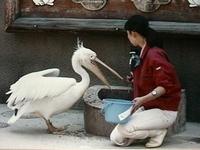
The first zoo opened in Japan in the year 1882. This was the Ueno Zoo, the oldest and perhaps the most famous zoo in Japan. Currently there are 90 member zoos registered with the Japan Association of Zoo and Aquaria but only 10 of these date back to the prewar period. The first wave of new zoos came in the 1950's during the economic boom that was to push Japan forward along the path to rapid economic and social development. During this time the need for new leisure facilities to attract and entertain the public grew tremendously and understandably so. 22 individual facilities began their operation during this period. There was, however, a second wave that saw the opening of a further 21 zoos. This second wave came in the 1980's, during the so-called "bubble economy". Here again the demand for entertainment for the masses grew with tremendous force and needless to say, the money to deliver such was available in abundance. But times are changing and most zoos are now struggling to make ends meet. There are two zoos that are exceptions to this. The Ueno Zoo in the central downtown area of Tokyo mentioned earlier as the oldest zoo in the country, and Asahiyama Zoo in the city of Asahikawa in the northern most island of Hokkaido. The latter has especially been the center of much media attention for several years now as one of the zoos to have succeeded in renovating their exhibits to emphasize the natural behavior of the animals. Whether or not these exhibits have truly been instrumental in enhancing the welfare of the animals is somewhat debatable but the attractiveness of the new exhibits to the public at large is unquestionable and the zoo has attracted a horde of visitors for some time now. This has certainly improved their financial situation. Not so lucky are the numerous other publicly owned zoos throughout the country. 71 of the 90 members of the zoo association are public facilities owned by the local government. This means that they are run on tax money. This also means that budget cuts in the local government seriously affect their activities. Needless to say, most local governments in Japan, be they town, city, or prefecture, are currently operating, or rather are being forced to operate, on a very tight budget. As a result many public zoos are now opting to use the "designated management" scheme. This scheme allows public facilities to entrust a part of their operations to a third party such as a private corporation or a non-profit organization. The scheme helps to upgrade the level of customer service as well as to cut costs. Currently 31 of the 71 public zoos have made use of the scheme. But this is certainly not a panacea for the huge epidemic of "poverty" now hitting most zoos. Zoos being what they are must expend large amounts of money for manpower and utilities, not to mention the cost of feeding their "exhibits". On the other hand it has been public policy to keep entrance fees at a minimum because of the "educational" role zoos should play in society. This means that the zoos are literally structured to "lose money". Unless the zoos in the country are able to find a means to boost their support structure, for example, to arouse public interest to procure more from the taxpayers, they will be continually forced to fight a losing battle. For how long?
Prepared for Zenoaq by Animal Literacy Research Institute
Sep.
2010
The Aftermath of the Foot and Mouth Disease
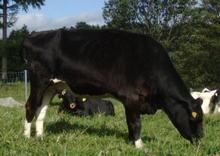
The world has for some time now been aware of the foot and mouth outbreak in Miyazaki Prefecture in the southwestern part of Japan on the island of Kyushu. The outbreak was, needless to say, a tremendous shock to the nation as a whole and furthermore, dealt a huge psychological and financial blow to the agricultural community in Miyazaki known for it's premium Miyazaki beef. The spread of the disease has finally been stopped and Miyazaki has finally been declared "clean" by the authorities. Livestock markets have reopened and things are getting back to normal again.
Looking back on the scars left by the epidemic the Japanese people are once again stunned by the magnitude of the damage done including the number of lives lost in the farms. Though much smaller in comparison to the outbreak that shook the whole of England years ago, nevertheless the losses were significant to the people of Japan, especially to the farming community of Kawaminami region in Miyazaki Prefecture where the outbreak first began.
28 percent of all the farms in Miyazaki were affected by the disease. This amounts to a total of 262 individual farms. 68,266 cows were lost which amounts to 22 percent of the entire prefectural population. 24 percent of the pigs in the prefecture also went down. This is 220,034 pigs. Furthermore, 343 "other animals" including goats, sheep,
and wild boars were also sacrificed. The disposal of the bodies was also a huge task. 252 individual land lots were assigned as "disposal/burial grounds" and the total surface area of these amounted to 1.42 square kilometers. The magnitude of the economic damages was just as great as the number of lives lost. The financial loss to the farming community has been calculated at approximately 235 billion yen.
Though the losses are great, Japan is now preparing to submit the necessary documents to the OIE in early October for review and evaluation. The review by the OIE is expected to lead to a final decision by next February. Japan is hopeful that they will once again be declared "clean".
Prepared for Zenoaq by Animal Literacy Research Institute
Aug.
2010
Service Dogs in Japan
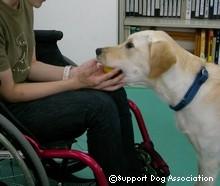
The service dog training and certification system in Japan is one of the most advanced systems in the world. Whereas many countries have a multitude of training organizations that supply a large number of service dogs for people with disabilities, Japan is slightly different. In order to train service dogs the organizations must have more than a local business license. They need to register themselves as a social welfare entity and must show proof of having a working relationship with a human medical expert, either in the form of an employee or a consultant. How do prospective users go about contacting a training organization and getting a working dog? The process in itself is very sophisticated which is what makes the Japanese system so unique. The first step is to consult with the relevant office of the local/regional government. This means that the person with the disability will first contact the Welfare and Disabilities Division of the prefectural government to inform them of his/her desire to obtain a service dog. The personnel of the division will inform them of ways to choose a reliable training organization as well as give out information concerning subsidies available from the government to cover the costs. The person is then encouraged to contact a training organization and to visit their facilities. This is a very important step in the process and the would ?be user is advised to take their time in choosing an organization that they feel the most comfortable with. When an appropriate organization is chosen the official system states that the organization should make a home visit to gather more information on the lifestyle of the would-be user to decide on what type of dog would best fit the person and the environment. As this step is included in the information that is given to the person during the initial enquiry, should the chosen training organization skip over this process, questions will no doubt be raised. After this process the person with the disability may apply for a government subsidy. Every prefecture has a subsidy system for assisting people with disabilities acquire a service dog. In reality the cost is not charged to the user by the training organization so the money goes directly to the organization to compensate for the costs incurred in placing a service dog with the applicant. After the organization chosen by the applicant has found a suitable dog for him/her and conducted basic training, the law stipulates that the organization must then put the applicant through what is called "joint training", or real life training for the end user. During this time the recipient will learn how to manage his/her dog as well as to give the appropriate care needed for the dog within the parameters of their living environment. The period for this training as written in the law is a minimum of 40 days for mobility service dogs.
Some training organizations will choose to conduct a part of this training in their own training center and then to move into the home environment of the recipient during the latter part of the training. Others will conduct this part of the training entirely within the home environment of the recipient. There have also been cases in Japan where the pair have spent a part of this training period in a medical rehabilitation facility where the medical experts were able to observe and evaluate their activities and to give pertinent advise about the efficacy and safety of methods being used to instruct the recipient in how to manage the dog. The final step for service dog placement in Japan is the official certification. All guide dogs, mobility dogs, and hearing dogs in Japan must be officially certified by an organization designated by the Ministry of Health, Welfare, and Labor. As mentioned before in this column, these 3 types of service dogs are the only kind written into the law to be given free access to public facilities. The certification process consists of a providing the necessary documentation for review and an actual test to evaluate the person-dog pair from various angles. Human medical experts will evaluate the safety of the dog and its movement for the person with the disability and dog training experts will evaluate amongst other things animal welfare considerations and reliability of the dog's movements. Furthermore both the training organization and the certifying body have a responsibility to follow up whenever their arises a necessity to do so.
This in a nutshell is the system currently being used in Japan for the placement of service dogs for people with disabilities. Some have criticized is as being overly strict and complicated but if we are thinking in terms of both human and animal welfare and well-being the process is indeed necessary.
Prepared for Zenoaq by Animal Literacy Research Institute
Jul.
2010
Alien Species
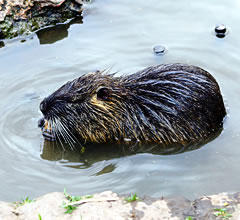
The invasion of domestic habitat by alien species is not a new problem for most nations. Certainly Japan is no exception to this rule. Raccoons, the Mississippi mud slider turtles, Taiwan squirrels...the list is long and varied. However , recently a certain animal has received much media attention because of its rate of proliferation as well as the damage it has caused to the surrounding environment. The culprit here is the nutria. Nutrias were brought into Japan sometime before World War II. They were imported for their fur. Nutria skins were utilized widely in military uniforms and there existed many fur farms and processing plants throughout the country. But as is always the case, humans are never such good stewards that the foreign animals, and plants, that they bring in under their care don not slip out into the domestic environment. Needless to say the nutria were no exception. These large rat-like creatures have now spread to various localities and has steadily become a nuisance to local populations, both people and animal. In terms of distribution the largest population of nutria is said to be found in Hyogo Prefecture. The nutria live along the river banks and are such good swimmers they move about freely in the water. This in addition to the fact that they are very wary of human beings makes them very hard to spot visually despite their numbers. The greatest damage the nutria are currently responsible for is their voracious appetite that has been unleashed on the local farm produce. Sure enough, they have had a large impact on the domestic natural environment. But the largest voices being raised against the nutria now are those of the farmers in localities where there are large populations of them. The nutria is a herbivore.....with a huge appetite for anything grown on the fields. They have devoured rice, leafy vegetables, fruits, lotus roots, potatoes....whatever the farmers see fit to grow on their land, they will eat. There have been immense losses for these farmers, especially in and around the Hyogo area. Since they are rather sneaky creatures, as stated earlier, the local communities have asked hunting organizations to set up traps in order to rid the area of these "pests". These traps have been successful to a certain extent in that individual animals were caught and culled. However, there is a limit to the number of traps that can be set up and the nutria population is VERY large. Furthermore, these animals breed several times a year with one mother producing at least 5-6 offspring each time. The trapping literally becomes a "cat and mouse game". Local authorities in the nutria infested regions are still struggling with the problem.
But.....who is to blame? The nutria certainly did not ask to be invited into the country.
Nor were they able to cross the seas on their own. Here again, intelligent, but stupid, man has created a big problem for himself. Let us hope that we can at least learn from these past mistakes of ours.
Prepared for Zenoaq by Animal Literacy Research Institute
Jun.
2010
The Growing Pet Care Market

The pet care business in Japan is currently growing rapidly. According to a survey of Japanese households, 39.4percent are currently living with pets ranging from goldfish to birds to dogs and cats. Furthermore, the survey reveals that 66.8 percent of the households would like to live with pets in the future, be it a continuation of their current situation or the acquisition of a new pet. Only 33.2 percent answered that they would not want to live with a pet animal. These statistics show that the need for goods and services in this area is certainly growing rapidly. How large, then, is the market today? The size of the total market in monetary terms is approximately 10 trillion yen.
Of this, the pet food industry accounts for about 2.8 trillion, other pet supplies, about 1.6 trillion, and related services about 6.9 trillion yen. This is indeed a huge market and needless to say, an ever widening one. The pet food market steadily approaching the 3 trillion yen mark can be divided into 3 main categories. 53 percent goes to dogs, 40 percent to cats, and 7 percent to other animals. Dogs are by far the holders of the largest market share. According to the Japan Kennel Club current trends in dog keeping have veered towards the acquisition of smaller breeds. Nearly 70 percent of the purebred dogs kept as pets are breeds under 10 kg in body weight. The 2009 JKC registration numbers show that the top breed in Japan today in terms of popularity is the toy poodle.
This is followed by Chihuahuas in second place, miniature Dachshunds in third place, and Pomeranians coming into fourth place. Of the top 10 breeds in the JKC registry, the largest breed by body size is the Shiba inu......which as we all know is certainly not a giant breed! Perhaps it is because of this particular trend that the percentage of indoor dogs has gone up considerably in recent years. The current percentage of dogs kept mainly indoors according to a survey conducted at the end of 2009 by the pet food industry association is 73 percent. More dogs in Japan are now truly "living with " their families. The market for these family members is now becoming widely diversified. For example, the auto manufacturer Honda has a website named "HondaDog". The site introduces models that are "dog ?friendly", with special features such as wider doors and lower bodies. Various accessories such as pet carriers and pet mats are introduced as well. Newly opened hobby classes cover a wide range of topics including crafting original leather collars for our pet dogs , cooking for your pet, and sewing for your pet. There is now a Japanese association of dog yoga classes......how far will all of this go?
We cannot predict the future course of pet keeping in this country but it is imperative that we also not overlook the negative aspects of this boom. Official statistics on complaints/trouble in apartment houses show that complaints concerning pet issues is no small matter. In terms of the number of complaints it ranks in second place after complaints concerning issues on noise.
The pet industry has certainly been very creative in showing pet owners how to use their yen in expressing their love for their pets...now it is time for them to start thinking about ways to enhance responsibility.
Prepared for Zenoaq by Animal Literacy Research Institute
May.
2010
The Future of Bears in Japan

In Japan there are two types of bears that roam the forests. The Japanese Black Bears live on the mainland of Honshu and the Brown Bears live on the northernmost island of
Hokkaido. The Japanese Black Bears were formerly found on the southern islands of Kyushu and Shikoku but are now basically extinct in these areas. Researchers have said that there are approximately 10-20 Black Bears still surviving on the island of Shikoku. Currently there are a little over 10 thousand wild bears in Japan but they are being exterminated at the rate of 10-20% per year. These bears are targeted by sports hunting but at the same time they have been killed as "dangerous animals" when they have wandered into the human community. From around the year 2006 there has been a sharp increase in the number of bears hunted down because of the "threat" they have posed to human beings. Needless to say, many of the bears appearing in the human communities are doing so because they are rapidly losing their natural habitat to human development. If bears have harmed any part of the human habitat the local government will enlist hunters to exterminate the "source of danger". However, in some Prefectures the local government conducts spring bear hunts as a "preventive measure",based upon the premise that there will indeed be a certain number of incidents every year. This is one of the reasons that the bear population is diminishing so fast nationwide. A majority of the deaths every year occur as a result of such "necessary culling", be they truly necessary or not. Japan also has several notorious bear parks, which are nothing more than concentration camps for bears. The bears are kept in overcrowded pits. The stereotypical behavior and the begging behavior (for food thrown by the spectators)is appalling. These bear parks have long been the target of criticism by international organizations such as the WSPA as well as domestic animal welfare groups.
Ainu, the indigenous people of Japan have historically called the bears "yama-oyaji"
which can literally be translated as "mountain father". They have traditionally looked upon the bears as the dominating figure, the head of the "natural household" so to speak. Now the Japanese people no longer look at bears as a father figure...nor do they appreciate the magnificence of the bear. This is a loss not only for the bears but for the Japanese people as well.
Prepared for Zenoaq by Animal Literacy Research Institute
Apr.
2010
Resident Cards for Dogs

Itabashi ward, one of the 23 wards which make up the city of Tokyo has started to issue residential cards to dogs living with their owners as ward residents. The issuing started in January as an attempt to encourage more dog owners to register their pooches. Needless to say, the Japanese national law requires all dog owners to register their dogs, but many owners do not take the trouble to do so. There are many reasons for this and one of them may be simple procrastination, but there may also be financial reasons as the dog license is issued for a fee. In any event, the Itabashi ward officials felt that giving out residential cards to dog citizens may be one way to encourage owners to legalize the status of their canine partners. In Japan all human residents must register with the authorities at their place of residence. Whenever applying for any official documents such as a driving license or a passport, Japanese nationals are required along with other official papers to submit a "proof of residence". There are cards issued by the ward, city, township offices with which one has been registered. A person moving from one region to another must officially move their registry as well. Thus a residential card is something that is very crucial to the lives of the citizens of Japan.
Issuing residential cards to canine citizens is very rare in the country. In fact the Itabashi ward office may be the first local government to actually do so. These cards are issued free of charge and lists all some of the dog's biodata. The card is about the size of a postcard and has a photograph of the dog printed on it along with the dog's name, address, birthdate, and records of vaccinations. Since rabies vaccinations are a legal obligation of all dog owners in the country, the ward officials hope that these cards will help the dog owning public to remember their responsibilities as legal guardians of these animals.
On another note, the dog registration system has been facing some issues in recent years not only from Japanese citizens but from certain foreign residents. To be specific Okinawa prefecture has been face with several cases during the past year of dangerous breeds roaming the cities. Last June a pit-bull mix attacked a farming station in the city of Uruma in Okinawa prefecture and killed a calf. Since last spring there have been 12 cases, 15 dogs total, of pitbulls, dobermans, and rotweillers roaming the streets and the police being called to deal with them. Of these 12 , 8 cases, 10 dogs, belonged to members of the U.S. military forces stationed in Okinawa. Japanese officials have asked the military to inform their personnel of Japanese canine laws. Whether or not this will improve the situation has yet to be seen. Needless to say there are responsible dog owners and the not so responsible folks wherever one looks but because of the political situation surrounding the future of the U.S. military bases in Japan, these dog issues could become more than what they really are. Irresponsible dog ownership truly makes the world a more difficult place to live in......in many ways.
Prepared for Zenoaq by Animal Literacy Research Institute
Mar.
2010
Favorite Pets for the Older Generation

Japan is known for the high percentage of purebred dogs in its pet dog population. Very recently one of the major newspapers conducted a survey to see what breeds were actually preferred by the people of the country. The survey targeted the 50 and over senior population as they are increasingly becoming the major part of the country's population. The most preferred breed of dog amongst the older generation of Japan is the country's national breed, the shiba inu. This is not surprising as the shiba has always been quite popular domestically. The runner up was more surprising. The next favorite breed was the Akita. This breed is large and often times difficult to handle. It comes as a bit of a surprise to see that many people are looking at the Akita as a preferable pet dog. This may in part be due to the popularity of the movie "Hachi" starring an ever loyal Akita. The third and fourth places go to the golden retriever and the Labrador retriever respectively. These two breeds have been popular amongst dog lovers in Japan for quite some time now perhaps due to their image as smart and helpful because of their use as guide and service dogs. The fifth place is again a big surprise. Coming into fifth place is another Japanese domestic breed, the Kishu dog.
These dogs are also know for their large size and somewhat stubborn nature. Like the Akita they are not easy to handle. Again it is a mystery why this particular breed should rank so high in breed preference. Perhaps the senior population have a stronger tendency to lean towards national breeds as compared to the younger generation. That would be one way to explain why these difficult dogs rank so high. The survey was conducted to find out not "what dogs are being kept" but rather to see what dogs people "want to keep". Therefore there may be an emotional factor rather that the practical dictating the decisions. Looking into what breeds are preferred by the younger generation a survey of the "under fifty" population ranked the shiba inu as the top breed. The shiba is certainly an all time favorite! The Akita came in second, again perhaps influenced by the movie. The golden retriever came in third but the Labrador ranked lower than in the senior population. The toy poodle ranked fourth after the golden retriever , followed by the miniature dachshund. These last two breeds are the ones seen most often walking the streets of Japanese cities and it is no wonder that they appear within the top ranks of the favorite breeds, though it is surprising that they do not appear in the top five of the "senior preferences". It is also interesting to note that the younger generation preferred smaller breeds as compared to the seniors.
As for cats, the most popular breed amongst all age groups was the Japanese bobtail.
Though there was a slight differences in order, the same cat breed appeared in the top five of both the older and the younger generation. These cat breeds were the American shorthair, the Persian, and the Russian blue. For both age groups, mixed breed cats came in fifth. Again it is interesting to note this difference between dogs and cats. In the dog survey mixed breeds did not appear . This is probably because as mentioned earlier , Japanese dog owners in general seem to prefer purebred dogs. And the same is not quite true for cat owners......why is that?
Prepared for Zenoaq by Animal Literacy Research Institute
Feb.
2010
Behavior Problems in Dogs
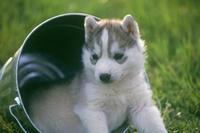
A private pet insurance company in Japan has been offering a behavior hotline service for its customers. Recently the company summarized some of the issues that
dog owners in this country have been faced with and released this information to
the local media. The contents of the dog behavior problems that have been
brought to the hotline are as follows.
The largest issue was that pertaining to house-breaking, or the toilet training of
dogs. Compared to the statistics for 2006, the number of calls in this particular
group of problems increased in 2008, from 21.9%to 25%. This would mean that one fourth of the callers were concerned about the toileting behavior of their pooches.
One wonders whether or not this would have any connection to the issue of the
sale of very young puppies that has plagued the nation for a long time.
During the last revision of the animal welfare law, many charities as well as
academicians and other experts lobbied for the inclusion of a clause that would
prohibit businesses from selling dogs under 8 weeks of age. Unfortunately this was not
included in the final version of the official draft presented to the Diet. The same groups
are lobbying yet again to have this taken up during the upcoming review of the law.
In the mean time very young puppies, some under 50 days are still being sold in pet shops around the country and this in many ways would be a large contributing factor
to the toileting issue, as puppies that have not stayed with the mother dog for a certain
period of time may be lacking in the necessary hygiene training "in the nest".
The second largest issue was biting. This, of course , can grow to become a very serious
social problem. Here again we see an increase from 18.6% in 2006 to 21.7%in 2008.
If one in every five callers is talking about his/her biting dog, the consequences for
society may be quite serious. This again may be traced back to an early separation
of the puppy from the litter, resulting in the sales of dogs who have not learned bite
inhibition through sibling play/interactions.
Another interesting trend would be the increase in the number of callers asking for
advice in living with multiple dogs. There seems to be a trend in owners especially of
smaller breeds to want to keep more than one dog in the household. Whereas only
3.3% of the calls were related to this issue in 2006, two years later the number doubled
to 6.5%!
A welcome trend was seen for barking behavior. There seems to be a slight decreasing
trend in the number of owners suffering from barking dogs. This is certainly very
welcome in a crowded country like Japan. The cause is hard to determine, as
dachshunds are still ranked high as one of the most popular breeds in the
country, and they certainly are not the most silent breed of dog.
Perhaps because of the steadily increasing percentage of dogs being kept indoors
the barking issue is either not given the chance to escalate as much or the indoor
barking does not result in as many neighbor complaints!
Though the survey does not cover a large number of dogs and owners it certainly
gives us some perspective on dog ownership in Japan.
It is also encouraging to see public and media interest in such issues. It is certainly
paving the way to the next review of the animal welfare law.
Prepared for Zenoaq by Animal Literacy Research Institute
Jan.
2010
Disaster-Preparedness of Pet Owners

Japan is a country of earthquakes. Though there have been other natural disasters such as hurricanes that have brought extensive damage to many parts of country, the one natural disaster that everyone is constantly preparing for is the "big quake". Researchers have said that the probability of a large earthquake hitting the Tokyo metropolitan area within the next three decades is about 70percent. The nation is only too aware of the huge earthquake that hit the Hanshin area in 1995.
Parts of the famous port city of Kobe were destroyed entirely by both the quake and the fire hazard that followed. Niigata on the Sea of Japan side of the country was also hit by a large earthquake in 2004. In both instances companion animals were involved in the tragedy just as much as their human partners. Japanese pet owners are now becoming increasingly aware of the need to "be prepared". Many large retailers in Japan have a section were emergency supplies and goods are sold. Needless to say, these supplies are for human use. Recently, a pet insurance company conducted a survey on the disaster-preparedness of Japanese pet owners and came up with the following results.
A little over 37% of pet owners had pet supplies stocked up. When asked about whether or not they had thought out evacuation procedures that included their animals, as well as destinations where their animals could accompany them, about 1/4 of the respondents said that they had done so Approximately 12 percent of the owners surveyed had already secured places where their pets could be boarded in case of a disaster. Whether these figures are seen as high or low depends on the perspective of each individual. However the surveyed population were those pet owners who had purchased an insurance policy for their pets from the company (conducting the survey) and thus may not reflect the true situation amongst the general public. In other words the figures depicting "preparedness" may infact be somewhat lower than those of the survey results. If that is the case, then the pet owners in Japan, the most "earthquake-conscious" country in the world may not be as well prepared as they should be.
Prepared for Zenoaq by Animal Literacy Research Institute
Dec.
2009
Encouraging Trends in Dog Ownership

Pet ownership in Japan is now a very familiar and an established phenomenon in society. Though there are many issues that the pet industry must yet resolve and many issues pertaining to animal welfare and poor husbandry that the owners and industry alike must face, there are just as many positive developments that merit our attention.
According to the pet care statistics published by the Japan Pet Care Association, there are some rather encouraging trends emerging within the dog owning community in Japan.
The statistics for 2008 published by the Japan Pet Care Association was compiled from a survey of over 2000 dog owners throughout the country.
The survey has shown some clear and interesting trends in dog-keeping. According to the data 68% of the dogs currently carry an ID. This means that a significant number of dogs can be returned safely to their owners, should some emergency situation result in a separation. Though one should say that this is true only theoretically, it is nevertheless an encouraging piece of data. However when the details pertaining to this item are scrutinized, we notice that only a little over 5 percent of the dogs have been micro chipped.
This means that a large number of dogs are still excluded from the network of a safe and reliable ID system. Perhaps the merits of micro chipping have not yet been promoted as much as is truly necessary. This is indeed food for thought for animal control authorities.
One more positive trend seen in the survey data concerned the dog's housing status. Quite surprisingly 70% of the dogs surveyed lived indoors. This means, of course, that a great majority of the dogs are indeed truly living with their family. Furthermore an additional 15% were kept indoors "most of the time"
This gives us an encouraging total of 85%. Compared to how dogs were kept in Japan a few decades ago this is a tremendous achievement.
There was however a discouraging piece of information that came from the survey. Of all the participating owners less than 5 percent obtained their dogs from public and private shelters.
Adoption of unwanted pets still needs a boost in terms of social education and promotional activities.
All in all the survey has effectively clarified what is being done right and what needs to be improved. Let us hope that 2010 brings even better results for us and for the dogs!
Prepared for Zenoaq by Animal Literacy Research Institute
Nov.
2009
"City Pets : Where do they Live and Where Do They Go"

Back in 1999, according to a real estate survey of all the new condominiums being put on the market, only 3% were open to the keeping of pets, in the Tokyo metropolitan area. However this percentage has increased steadily and for the year 2008, a decade later, the number is now 75%.
This is an amazing increase. Needless to say the rental market is still far behind in such figures. Landlords seem to worry still about the negative effect pets will have on the living environment.
On the other hand, there are a few apartments that can be rented only by pet owners. Several years ago an apartment building went up on the outskirts of Tokyo with the purpose of renting only to dog owners. This is not a very common phenomenon, but now and them people do come across such real estate. The increase in accessible places for pets and their owners is not limited only to housing. There are an increasing number of hotels and holiday sites that will allow travelers to come with their pets.
Karuizawa is a very popular high end resort for city dwellers located in the mountains of Nagano Prefecture.
This popular resort hosts 7~8 million visitors every year. The official city guidebook has placed a dog mark besides all those hotels and restaurants that allow owners to come with their pets.
Of the 168 hotels listed in the guidebook 34 are listed with the dog mark, not an insignificant number. What does this all mean to the pet owners? Well, it means that their pets will have more public access.
But it also means that they must be more responsible concerning the way their pets, especially dogs, behave in public. In 2001 a woman broke her leg in a fall which was induced by her being startled by a barking dog. The district court stated the owner's responsibility in training the dog, or lack of which caused the accident and ordered the dog's owner to pay over 4 million yen in damages. So・・・・ all that public access is fine but owners must be aware of what responsibility this places on their shoulders.
Prepared for Zenoaq by Animal Literacy Research Institute
Oct.
2009
Hunting Dolphins

The small seaside town of Taiji in Wakayama Prefecture has suddenly gained world fame with the opening of a new movie, "The Cove".
"The Cove" received the Audience Award at the prestigious Sundance Film Festival this January. The film is about the dolphin drive hunts that take place in the aforementioned seaside town of Taiji. The Japanese fishing industry is reported to hunt about 20,000 dolphins every year but a great majority of them are killed by harpooning in open waters.
But in Taiji the dolphins are hunted in a very different way.
The fishermen of Taiji use Special equipment to create a sound barrier around dolphins swimming in the open sea. They use this "wall of sound" to drive the dolphins into a cove where they are killed. Taiji is the only place where the dolphins are herded to shore like this during the hunt.
The dolphins driven into the cove are speared by the fishermen, with the exception of a few creatures who are caught and sold to aquariums for over 100,000 dollars each.
The town of Taiji is and the cove where the hunt takes place is in an isolated location and very few outsiders have been able to observe the actual hunt.
The U.S.-made film, "The Cove" made use of divers and underwater cameras, aerial shooting, thermal cameras etc. to document the hunt undercover.
The release of this documentary has caused a large wave of "Japan bashing" throughout the world. The only people who do not know about this are the Japanese themselves. Most Japanese have never eaten dolphin meat and needless to say most Japanese living outside of Taiji have never heard of the "drive-hunts". This portrays a serious flaw in the Japanese media.
Since the release of "The cove" the Japanese media have taken up the Taiji issue in bits and pieces, mostly in the form of interviews with local residents and officials, who have all repeated the age old phrase "cultural practice" in defense of these hunts. Some local fishermen and even officials have stated that killing dolphins for meat consumption is like killing pigs and cows. But the media has yet to touch on the humane slaughter angle. The people of Taiji and the media interviewing them fail to see that the real issue lies in the brutality of herding and slaughtering methods. Needless to say, the humane treatment of food animals is now a large issue worldwide. "How" those cows and pigs are killed for meat is of interest to many consumers throughout the world. Thus, in the case of dolphins it should be the same if they are being equated to other food animals. The Japanese media, the people of Taiji, and government officials have completely "missed the point".
The media also does not report in detail the danger from mercury levels in dolphin meat.
Dr.T.Endo from the Health Sciences University of Hokkaido has conducted several studies looking into the mercury levels of Taiji residents.
He and fellow researchers found that the people of Taiji had average mercury levels that were approximately 10 times the national average. Such alarming figures have also never made the headlines in the Japanese media. The Taiji issue should first and foremost be attacked from the angle of "the people's right to know". The Japanese people should be the ones to decide whether or not the "cultural practices" of a handful of their fellow citizens is indeed harming the national identity and if so then they again should be the ones to decide what they should say and do about it. And to do so the makers of "The Cove" must find a distributor in Japan ... if not, well, there's always the Internet.
Prepared for Zenoaq by Animal Literacy Research Institute
Sep.
2009
Price are going up for Pets, Too!

Hard times have hit many people around the world as economies flounder to keep afloat. But despite the cutbacks that many households are making in their budget the cost of pet keeping is steadily on the rise.
According to Anicom, a pet insurance company operating in Japan, the various costs incurred in keeping a pet dog or cat has gone up by about 20% in 2008 as compared to 2007.
According to the results of a survey done by the company in early 2009, the largest outlay by pet keeping households in 2008 was under the item "food and treats".
For dogs the average amount for the entire year of 2008 under this item was about 600 U.S. dollars. For cats it was about 400 dollars. The next most costly item was veterinary medical care for illnesses and injuries. This was about 350 dollars for dogs and 200 dollars for cats. However the survey included another item titled "vaccinations and preventive care".
When the amount listed under this item was added to the above the average total for both dogs and cats came to approximately the same as that for "foods and treats".
For Dogs, another large budget item was grooming at about 300 dollars per annum, whereas for cats this was a mere 50 dollars.
All in all the sum total for all the budget items for dogs was approximately 2500 U.S. dollars for the year 2008. In 2007 the figure was 2000 dollars. For cats the figure for 2008 was about 1200 dollars as compared to 1000 dollars in 2007. However these numbers must be understood as merely average figures. There are many pet owners on both the lower and higher ends of the scale.
For example under the item "boarding and pet sitting" the average annual figure for dogs is approximately 100 dollars and for cats a very minimal amount of a little over 20 dollars.
Needless to say there are people who will have family members look after their pet when they are away, but on the other hand there are cases where owners have reported spending thousand of dollars in boarding fees for multiple pets when going on long vacations
In any event under current prices in Japan it is estimated that a large dog, such as a golden retriever, will cost the household approximately 50 thousand U.S. dollars in its life time.
A smaller dog will cost 30 thousand dollars. This amount is large enough that it should certainly be considered in the financial planning and cash flow projections in any household contemplating the acquisition of a new pet.
Experts warn that the largest medical expenses fall on the family when their pet beings to reach middle and old age. This means that when you acquire a puppy for your growing child, these expenses will start coming after about 10 years. This is also when large educational outlays such as college tuition descend on the family. Keeping pets can be expensive in Japan, and in other countries as well.
But most people will agree.... they are worth more than their keep.
Prepared for Zenoaq by Animal Literacy Research Institute
Aug.
2009
Current Conditions in Animal welfare

Though many people have negative emotions about euthanasia of unwanted animals in shelters or by animal control, Japan has successfully cut down on the rate of euthanasia during the past decade.
Around 1997 the total number of dogs and cats "put down" by animal control authorities of prefectural governments was around 600~700 thousand.
However in the 2007~2008 period this number has moved down to approximately 300 thousand. In other words, for dogs and cats, euthanasia has gone down by 50% in a 10year period. This is quite remarkable as numbers go, but unfortunately the decrease is due mainly to the fact that fewer and fewer dogs are being put down.
The euthanasia of unwanted dogs has now gone down to 1/3 of its level in 1997. With cats the decrease is, unfortunately, not so spectacular. There is a need to increase spay neuter programs as 80% of the cats euthanized by animal control are kittens. Many local bodies are financially supporting TSNR programs, but the effort needs to be stepped up. For example of all the wards and townships in the Tokyo metropolitan area only about 50% provide any form of subsidy for TSNR programs run by animal welfare charities.
However it is encouraging to see that some local governments have joined hands with local citizens and volunteers to become directly involved in TSNR programs within their jurisdiction.
One disturbing aspect of dogs and cats "dropped off" at animal control, is the number of animals being thrown out by puppy-mill operators. Though all animal businesses must now be registered with the local authorities, the standards for registration are still minimal and inspection infrequent due to a lack of manpower. The animal welfare law in Japan penalizes those who "dump" their animals on the streets, the maximum penalty here being 500 thousand yen. However surrendering your animal to animal control is not an offence whatever the reason.
This gives puppy millers a good excuse to "unload" the unwanted animals at no cost to themselves. With fewer stray animals and an increasing number of knowledgeable, responsible owners a further marked decrease in euthanasia rates can be hoped for throughout the country, but if the puppy mill issue is not resolved it will be a while yet before we are able to realize our ideals.
Prepared for Zenoaq by Animal Literacy Research Institute
Jul.
2009
Badgers and Foxes : Pranksters in Japanese Lore
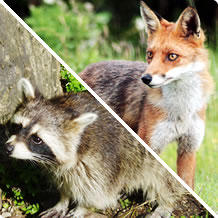
In Japanese folklore there are two animals that are forever trying to trick the human beings around them.
Sly foxes are also abundant in Western folk tales and comes as no surprise when they also appear in Japanese tales. But the Japanese badger, or tanuki as they are called, is probably not a very familiar character. Both the fox and the badger are capable of changing forms in Japanese folk tales. They are able to turn themselves into humans, other animals, and even inanimate objects. There is a very famous children's tale of a badger who turns himself into a pot to help an old man. The man is able to sell the pot to an antique dealer to earn some money. This tale "Bunbuku Chagama"(Bubbling Teapot) is a classic fairytale known to all Japanese children. The budger is a much loved character in Japan and they are found in front of shops in many localities.
Of course these are not live badgers, they are large clay figures produced in several areas throughout the country famous for their pottery. Shigaraki and Kasama are two of the most famous pottery towns that also produce badgers.
These badgers are all depicted in human attire, standing an their two hind legs. Typically they would be wearing a wide brimmed straw hat and holding a bottle of sake and/or an account book, the kind used by merchants in the older days to keep track of all the goods the customer has bought on credit.
The fox tales are slightly more "trickier" than the badger tales. The foxes and badgers in Japan have also been known to turn objects into different things to trick human beings.
A favorite prank of theirs is to turn leaves into money and shop off the unsuspecting human. There are slightly nastier tales of foxes fooling travelers at night, making them stay in "fake hostels".
The inn is a broken down temple, the hot spring is a cesspool in the fields, and the beautiful servant girl is a fox in disguise. The traveler may also have dined on dumplings, or rather horse droppings, in reality!
Kitsune, the fox, and tanuki, the badger are certainly very interesting characters in the world of Japanese folklore. But there is an idiom in the Japanese language "a competition of trickery between the fox and the badger" meaning two con-men trying to outdo the other.
Needless to say the idiom is used quite often to describe the goings-on in the world of politics.
As any Japanese person would tell you there are many kitsune's and tanuki's in the political world!
Prepared for Zenoaq by Animal Literacy Research Institute


